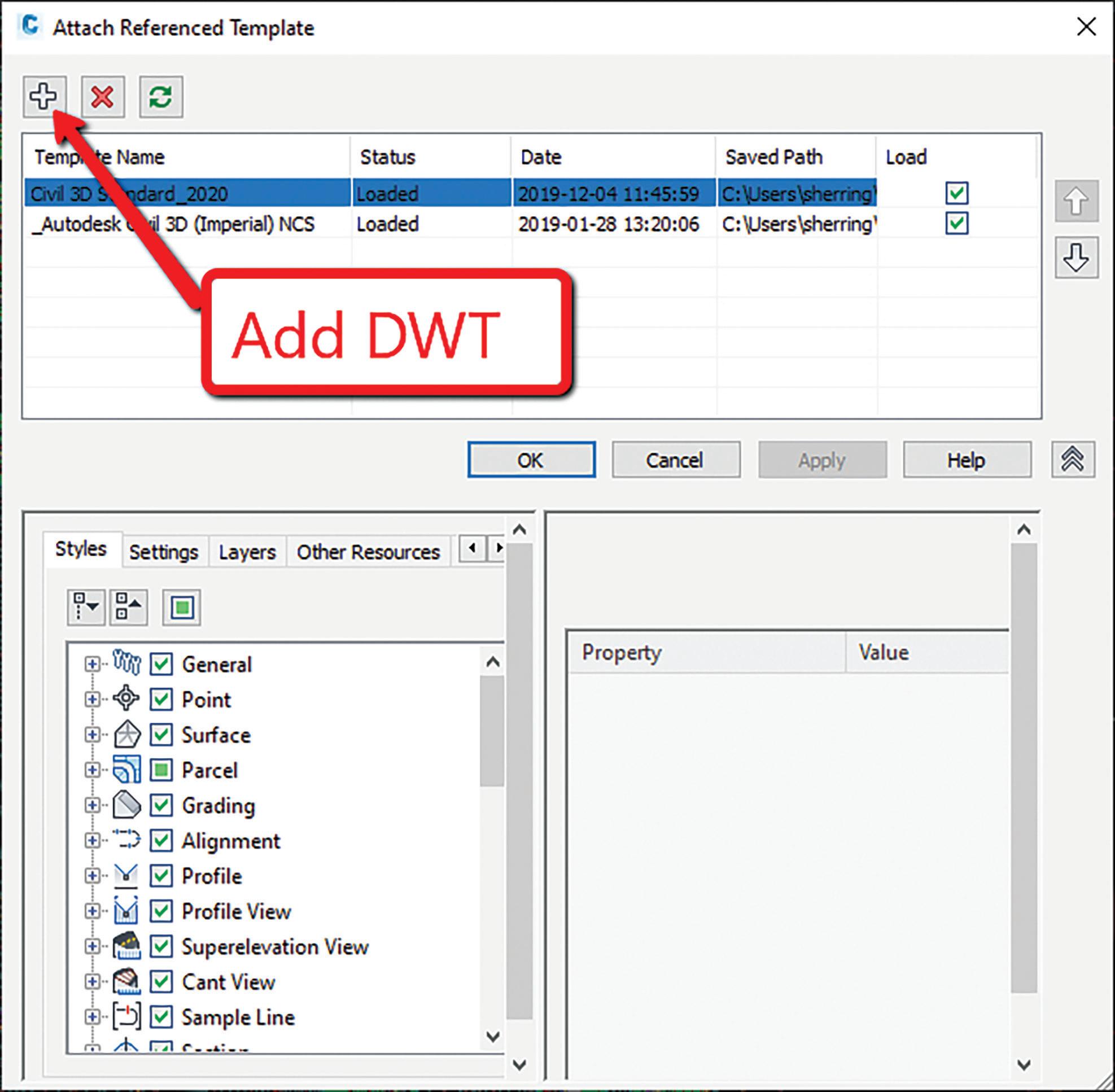
7 minute read
Civil 3D
from AUGIWORLD
by AUGI, Inc.
gutter setting every single time you use it? I do that all the time and it drives me nuts! Adding the curb to a new palette and changing the properties once will save you a lot of time.
Creating a custom palette is super simple! Add individual assemblies, blocks, script routines, and much more. Palettes can be on your local machine, or preferably shared throughout the company on a server (or both)!
First, I would remove any palettes you never use. You can right click on the heading of your palette and go to Customize Palettes.
Now give this a shot. Right click on any tab of your Tool Palette and select New Palette and name your palette.
Then, for this example, we will add a few subassemblies to the palette. You can select any subassembly, right click, copy and paste it to your new palette. You can add things like text and line separators to help clean it up a bit (Figure 7)..
Figure 6
MANAGING STYLES
Maybe the toughest thing to manage overall? Who is in charge? Who can make template changes? Many companies are pretty relaxed on this, but many also have very strict CAD standards they have to adhere to (either self-imposed or client). Some projects drag on for years, and how do you know that they are using the most updated standards?
How about referenced templates? This came out in circa-2017 (or 18). From the Manage tab of the ribbon, to the far right on the Styles panel, choose Reference.
This will allow you to add in your template, or multiple templates! See Figure 8.
When a user goes to edit a style, they will get this warning! This is a great way to manage styles as you will have one source file of styles to edit. See Figure 9.
Now, if only Autodesk would add in a pushback button where you can edit styles in a current drawing and push it to the master template!!

Figure 7
FILE MANAGEMENT / CLEANUP
Keeping files clean, clear of corruption and working smoothly throughout the project lifecycle is next to impossible with Civil 3D. And please…. please let me know of any solutions you may have! Here are a few things I do to help mange file size and stability. Just type in some of these commands on those troubled files.

Figure 8

Figure 9 • PURGE (Regapps) • XREF CONTAMINATION - Purge them, save, close, and then reopen the DWG. Those REGAPPS will be back if they are in the xreffed file.
• PURGE
• OVERKILL
• WBLOCK
• This is the number one way to really purge unused layers, blocks, REGAPPS, and any other funky junk that someone has done to that drawing. It will even remove bad settings that a user has changed! The Entire File option will take drawing layouts with it, which is great if you have a corrupt Sheet file.
• AUDIT
• RECOVER and RECOVERALL.
• MAPCLEAN
• Drawing Purge Add in • https://apps.autodesk.com/ ACD/en/Detail/Index?id=377 3138176974634673&appLang =en&os=Win32_64&autostar t=true
• LAYOUT TABS
• Autodesk recommends no more than seven layout tabs per drawing. I recommend no more than 3-5. Technically, you can add 256…AND I HAVE SEEN THIS BEFORE! Most people on the forums say between 5-10 layouts are the max they will use. • CIVIL 3D LABELS
• Use data shortcuts and label live in the sheet files. Try not to label a really long profile, corridor, or large surface that spans multiple sheets. This can really slow down the

Figure 10
performance because AutoCAD and Civil 3D will process/cache every object whether you are viewing it or not. Also, use XCLIPS. • TURN OFF THESE SETTINGS
• Hardware Acceleration
• Smooth Line
• HPQUICKPREVIEW • Controls whether a hatch preview is displayed when specifying a hatch area.
MANAGING SURFACES (DXF/POINT CLOUD)
I see a lot of people struggling with creating surfaces from GIS data, specifically large datasets with a lot of contours. Users tend to import as polylines and add the polylines, with millions of vertices, to a surface and wonder why the slowdown or crashing happens.
Did you know that if you create a surface from contours (polylines) you can delete those polylines and keep that surface in place!! A CAD file with millions of vertices of a polyline can be very slow. Simply go into your surface properties, BEFORE YOU ERASE THE POLYLINES, and change the build definition as shown above! See Figure 10.
Problems with large surfaces? The term “large surface” applies to a surface with a number of points exceeding one million (generally, 1 million points for a grid surface or a snapshot of a TIN surface, and 2 million points for a TIN surface).
When you save files with large surfaces, you may have noticed Civil 3D create a .mms (TIN) or .grs (GRID) file that it stores in the same folder as your DWG. But within those large surfaces, do you really need 100 million points? Try something like simplifying your surface in order to make the file, the surface and the external surface files smaller. I’ve seen many times where a simplification of the surface doesn’t lose it’s quality, and the .mms will be removed.
Note: Every time you move the drawing file to a different location, you must move the companion file to the same location. At times this causes issues, especially if users delete the .mms without understanding what it does.
CONCLUSION
Create a plan and stick to it! All the management best practices in the world will not help if it’s not documented, reviewed regular and most importantly ENFORCED!
Other items such as sheet set manager, file organization and best practices can be documented easily in some sort of a CAD Manager handbook. Monthly, or quarterly, meetings to review best practices and even items such as template changes are also a good idea. If I only followed half of the stuff I mentioned above I would be in much better shape!!
Thanks for reading.
Shawn has been a part of the design engineering community for roughly 15 years in all aspects of design, construction and software implementations. He has implemented and trained companies across the Country on Civil 3D and other infrastructure tools and their best practice workflows. Shawn can be reached for comments or questions at sherring@ prosoftnet.com.
AUGI Members Reach Higher with Expanded Benefits

MEMBER
AUGI is introducing three new Membership levels that will bring you more benefits than ever before. Each level will bring you more MEMBER content and expertise to share with fellow members, plus provide an expanded, more interactive website, publication access, and much more!
MEMBER
MEMBER MEMBER MEMBER
DUES: Free
DUES: $25
MEMBER Professional members have access to: • Forums • HotNews (full access) • AUGIWorld (full access and in print) • ADN 2013 Standard
Membership Offer
DUES: $100
Are you ready to upgrade yourself and your membership? Access additional benefits and upgrade at www.augi.com
Learn how to configure the ideal workstation, then save $500 on the ultimate Autodesk workstation




Download our exclusive eBook, How to Configure Your Revit Workstation, packed with vital details and expert insight you won’t find anywhere else.




Then, for a limited time, save $500 on your purchase of an APEXX S3, the world’s fastest Autodesk workstation featuring an Intel® Core™ i9 at 5.4GHz, up to two NVIDIA RTX™ GPUs, and purpose-built for Revit, AutoCAD, 3ds Max, and more.
Get the eBook and Save ›
(888) 302-0223
512-852-0400








